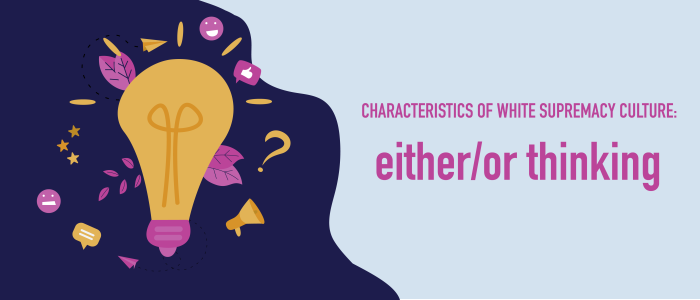
Analyzing white supremacy culture in the workplace: A series
Jun 27, 2022
A phrase that sticks with me every day is:
“Think about these stereotypes, these omissions, these distortions as a kind of environment that surrounds us, like smog in the air. We don't breathe it because we like it. We don't breathe it because we think it's good for us. We breathe it because it's the only air that's available.”
Beverly Daniel Tatum, PhD
In every institution and every system — including schools, housing markets, and even your favorite grocery stores — white supremacy culture exists. It is like the mosquito bite that you get that turns into a bad allergic reaction every time. But there are ways to get some medicine on that bite and to cleanse our “air” quality currently contaminated with the smog of white supremacy. So, let's examine the white supremacy culture, how it manifests itself in the workplace, and how we can root it out.
What is white supremacy culture?
It is important to define what white supremacy is before talking about white supremacy culture. The Dismantling Racism workbook defines white supremacy as thinking white people and their ideas, thoughts, beliefs and actions are better than people of color and their ideas, thoughts, beliefs and actions.
White supremacy culture builds upon that notion and expands it by infiltrating our beliefs, values, norms, standards of our groups (many if not most of them), our communities, our towns, our states and our nation, teaching us both overtly and covertly that whiteness is valuable, that whiteness holds value, and that in order for anyone to gain value, they must utilize whiteness to do so.
Deconstructing the characteristics of white supremacy culture
There are 13 main characteristics of white supremacy culture:
- Paternalism
- Perfectionism
- Either/or thinking
- Fear of open conflict
- Objectivity
- Quantity over quality
- Worship of the written word
- Defensiveness
- Power hoarding
- Individualism
- Right to comfort
We are going to talk about one of them and how it affects the workplace: Paternalism.
Paternalism: The veil of absolute power
In paternalism, decisions are generally made by those with power, while those without power are unsure of the logistics of anything. Paternalism stems from the discriminatory system of patriarchy, which entails an inequitable distribution of wealth, power and resources based on a system of relationships, beliefs and values that facilitate women's inferior position in the family. Those in positions of power see those without power as incapable of making decisions, and they don't always consider it vital or important to understand the viewpoints and experiences of those they make decisions for. Think of it as similar to the way a parent views their relationship with their young child. You will see this type of manager in just about every organization with a hierarchical leadership structure.
Lateral leadership
One strategy that can be utilized to undermine paternalism in the workplace is lateral leadership. Efficacy of decision-making is affected by lateral leadership as it lifts the veil of secrecy from decision making. Also, regardless of the individual’s positionality in their company's overall hierarchy, this leadership style allows people to take ownership of projects and strategic design. By adopting this strategy, managers can foster a healthy culture of trust in which employees can work independently, manage each other and take responsibility.
What lateral leadership looks like in action:
A PR agency's team members can utilize this newfound freedom to take their own initiative on projects and incorporate new marketing strategies to strengthen their relationship with clients.
Decision making transparency
Another strategy worth considering is transparency. This is especially relevant to hierarchical transparency. It is important to communicate openly with your team about who is responsible for what and how changes are made. A supervisor's decision making can be empathetically observed and better understood when this is done.
What transparency looks like in action:
A PR team can implement this by going over the approval process for content designs or purchasing equipment or tech for the office that will boost productivity. If the communication is effectively and efficiently routed through the right departments rather than going through supervisors who relay messaging, we avoid the middleman and ensure things are done effectively and efficiently.
— — —
Lateral leadership and hierarchical transparency are just two strategies that can move the needle in the PR industry — an industry that is driven by equity-based principles.
You may be wondering what this means and why it's important. Well for starters, dismantling white supremacy culture can lead to a work environment that encourages more effective communication and creates a positive atmosphere that will not only boost productivity and morale but also creates a benchmark for new employees joining your organization to follow. Also, who doesn’t want to be less aligned with white supremacy?
To learn more about the characteristics of white supremacy culture, please refer to the dismantle racism homepage for more information.
##
Cortez Washington is the Diversity, Equity and Inclusion Specialist for Piper and Gold. He currently resides in Milwaukee, Wisconsin but is a native of Battle Creek, Michigan.


